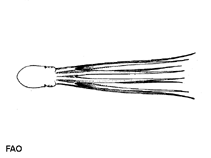Octopus salutii Verany, 1839
Spider octopus| Native range | All suitable habitat | Point map | Year 2050 |

|
| This map was computer-generated and has not yet been reviewed. |
| Octopus salutii AquaMaps Data sources: GBIF OBIS |
Classification / Names Common names | Synonyms | CoL | ITIS | WoRMS
Cephalopoda | Octopoda | Octopodidae
Environment: milieu / climate zone / depth range / distribution range Ecology
Benthic; depth range 70 - 700 m (Ref. 96968), usually 250 - 500 m. Subtropical; 45°N - 27°N, 14°W - 37°E
Distribution Countries | FAO areas | Ecosystems | Occurrences | Introductions
Mediterranean Sea and Northeast Atlantic: from Spain south to Morocco, and the Mediterranean.
Length at first maturity / Size / Weight / Age
Maturity: Lm ? range ? - ? cm Max length : 16.5 cm ML male/unsexed; (Ref. 96968); max. published weight: 750.00 g (Ref. 96968)
Life cycle and mating behavior Maturity | Reproduction | Spawning | Eggs | Fecundity | Larvae
Main reference
References | Coordinator | Collaborators
Quetglas, A, M. Gonzales, A. Carbonell and P. Sánchez 2001 Biology of the deep-sea octopus Bathypolypus sponsalis (Cephalopoda: Octopodidae) from the wetern Mediterranean Sea. Mar. Biol. 138:785-792. (Ref. 1958)
IUCN Red List Status
(Ref. 130435: Version 2025-1)
CITES status (Ref. 108899)
CMS (Ref. 116361)
Threat to humans
Human uses
Fisheries: commercial
| FishSource |
Tools
More information
Max. ages / sizes
Length-weight rel.
Length-length rel.
Length-frequencies
Mass conversion
Abundance
Internet sources
BHL | BOLD Systems | CISTI | DiscoverLife | FAO(Publication : search) | Fishipedia | GenBank (genome, nucleotide) | GloBI | Gomexsi | Google Books | Google Scholar | Google | PubMed | Tree of Life | Wikipedia (Go, Search) | Zoological Record



